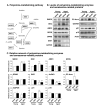Inhibition of Polyamine Catabolism Reduces Cellular Senescence
- PMID: 37686212
- PMCID: PMC10488189
- DOI: 10.3390/ijms241713397
Inhibition of Polyamine Catabolism Reduces Cellular Senescence
Abstract
The aging of the global population has necessitated the identification of effective anti-aging technologies based on scientific evidence. Polyamines (putrescine, spermidine, and spermine) are essential for cell growth and function. Age-related reductions in polyamine levels have been shown to be associated with reduced cognitive and physical functions. We have previously found that the expression of spermine oxidase (SMOX) increases with age; however, the relationship between SMOX expression and cellular senescence remains unclear. Therefore, we investigated the relationship between increased SMOX expression and cellular senescence using human-liver-derived HepG2 cells. Intracellular spermine levels decreased and spermidine levels increased with the serial passaging of cells (aged cells), and aged cells showed increased expression of SMOX. The levels of acrolein-conjugated protein, which is produced during spermine degradation, also increases. Senescence-associated β-gal activity was increased in aged cells, and the increase was suppressed by MDL72527, an inhibitor of acetylpolyamine oxidase (AcPAO) and SMOX, both of which are enzymes that catalyze polyamine degradation. DNA damage accumulated in aged cells and MDL72527 reduced DNA damage. These results suggest that the SMOX-mediated degradation of spermine plays an important role in cellular senescence. Our results demonstrate that cellular senescence can be controlled by inhibiting spermine degradation using a polyamine-catabolizing enzyme inhibitor.
Keywords: acrolein; aging; polyamine metabolism; senescence; spermine oxidase.
Conflict of interest statement
The authors declare no conflict of interest.
Figures




References
-
- Stites S.D., Harkins K., Rubright J.D., Karlawish J. Relationships between cognitive complaints and quality of life in older adults with mild cognitive impairment, mild alzheimer disease dementia, and normal cognition. Alzheimer Dis. Assoc. Discord. 2018;32:276–283. doi: 10.1097/WAD.0000000000000262. - DOI - PMC - PubMed
-
- Ocana P.D., Darabseh M.Z., Ishihara K., Aburub A., Zambolin F., Montgomery G., Mills R., Scorcelletti M., Cameron J., Ganse B., et al. Age-related declines in muscle and respiratory function are proportionate to declines in performance in master track cyclists. Eur. J. Appl. Physiol. 2021;121:3447–3457. doi: 10.1007/s00421-021-04803-4. - DOI - PMC - PubMed
MeSH terms
Substances
Grants and funding
LinkOut - more resources
Full Text Sources
Research Materials
Miscellaneous

